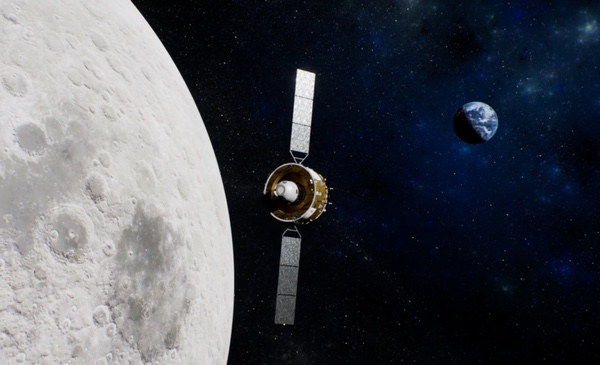What is China doing at the lunar distant retrograde orbit?by Kristin Burke
|
| It was no mystery that CE-5 would continue China’s trend for mission extensions. |
China intends to launch the CE-7 probe between 2024 and 2025 to the lunar south pole. CE-7 is composed of five separate spacecraft, namely an orbiter, lander, rover, hopping probe, and a polar relay satellite. CE-7 cannot use China’s current lunar relay satellite, Queqiao, orbiting the Earth-Moon Lagrange Point 2 (E-M L2) because Queqiao’s specific E-M L2 position isn’t able to support a landing closer to the lunar south pole, according to a detailed Chinese media report.[11] To achieve precise landing determination, CE-7 will release its relay satellite before the other four components move into lunar orbit. Chinese academic articles describe that CE-7’s relay satellite will eventually be networkable with Queqiao and probably become the first components of China’s future lunar communications and navigation architecture for deep space exploration, and robotic and crewed missions.[12,13]
China has consistently built backup spacecraft for its national missions and upon achieving its primary goals, Chinese engineers use the backups for science and technology tests to support future missions. The Chang’e 2 was the first such mission extension.[14] In the case of CE-5, it is not a backup but composed of many components in order to achieve China’s multi-stage lunar sample return mission. After delivering the return capsule to Earth orbit in December 2020, CE-5 has used the remaining 200 kilograms of propellant to first travel to Earth-Sun Lagrange Point 1, where it conducted space environment tests and snapped a picture of the Earth and the Moon.[15,16] It then seems to have proceeded back to lunar orbit in September 2021.[17] Space trackers, as of January 2022, believe they have identified CE-5 in DRO.[18]
It was no mystery that CE-5 would continue China’s trend for mission extensions. The 2014 Chang’e 5-T1 tested very similar spacecraft components and fuel reserves for the lunar sample return mission, so Chinese planners knew how much reserve fuel they would have if it wasn’t used for any emergency measures.[19] China also shared insights with the global community on CE-5’s mission extension. During the Global Space Exploration Conference (GLEX) in June 2021, normally widely attended under non-COVID conditions, the CE-5 Deputy Chief Designer shared with reporters that the spacecraft would return to the Earth-Moon system.[20]
Endnotes
- China Lunar Exploration Program, “关于开展探月工程四期嫦娥七号任务载荷竞争择优的通知,” 082020.
- Liu Lei, et al, “OmniUV: A Multi-Purpose Simulation Toolkit for VLBI Observation,” (Draft submitted 01/2022).
- Gao Zhaoyang, et al, “Coverage Analysis of Lunar Communication/Navigation Constellations Based on Halo Orbits and Distant Retrograde Orbits,” 03/2020.
- 曾豪, et al, “地月 Halo 与 DRO 支持的往返月球任务轨道,” 宇 航 学 报, 12/2021
- Shanghai Astronomical Observatory, Chinese Academy of Science, “探月与航天工程中心主任刘继忠一行考察调研上海天文台指控中心与天马望远镜,” 07/2021.
- Scott Tilley, “What in tarnation is a Distant Retrograde Orbit (DRO)?,” 01/2020.
- China Lunar Exploration Program, “关于开展探月工程四期嫦娥七号任务载荷竞争择优的通知,” 082020.
- Zhang Lihua, “Development and Prospect of Chinese Lunar Relay Communication Satellite,” 10/2020.
- Liu Lei, et al, “OmniUV: A Multi-Purpose Simulation Toolkit for VLBI Observation,” (Draft submitted 01/2022),
- Gao Zhaoyang, et al, “Coverage Analysis of Lunar Communication/Navigation Constellations Based on Halo Orbits and Distant Retrograde Orbits,” 03/2020.
- Sohu, “嫦娥七号有多难?五台航天器合体内含新月球车,还要制造人工月震,” 12/2021.
- Zhao Kanglian et al, “Network protocol architectures for future deep-space internetworking,” 04/2018.
- Wu Xiaobo et al, “Modelling and Simulation of Dynamic Connectivity in Different Cislunar Satellite Constellations Networking,” 2012.
- Gunter’s Space Page, “CE2.”
- Sohu, “嫦娥七号有多难?五台航天器合体内含新月球车,还要制造人工月震,” 12/2021.
- Andrew Jones, “China's moon-sampling Chang'e 5 probe beams home eerie images from deep space,” 05/2021.
- Ibid.
- Andrew Jones, “A Chinese spacecraft is testing out a new orbit around the moon,” /a> 02/2022.
- The Space Report, “CE-5T1,” 2017.
- Andrew Jones, “China's moon rocks are ready to be loaned out for science research,” 06/2021.
Note: we are using a new commenting system, which may require you to create a new account.
